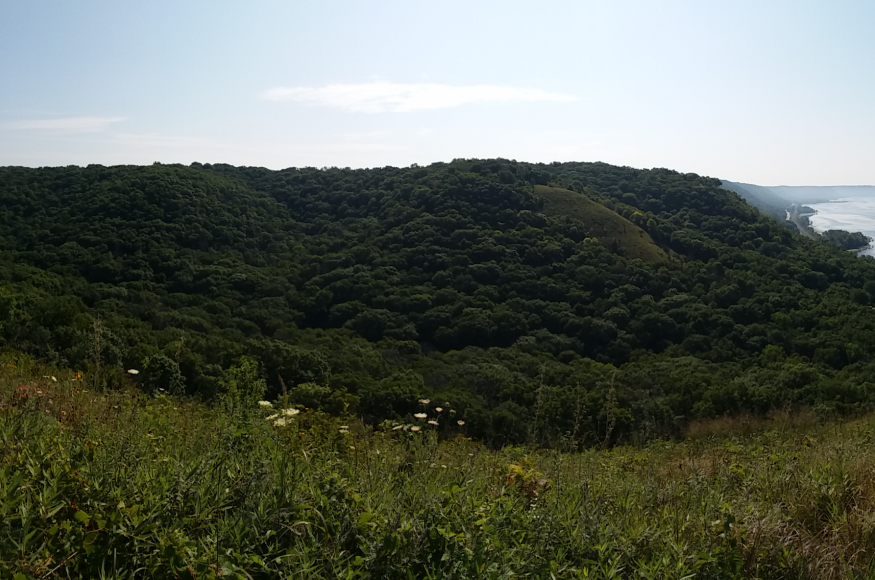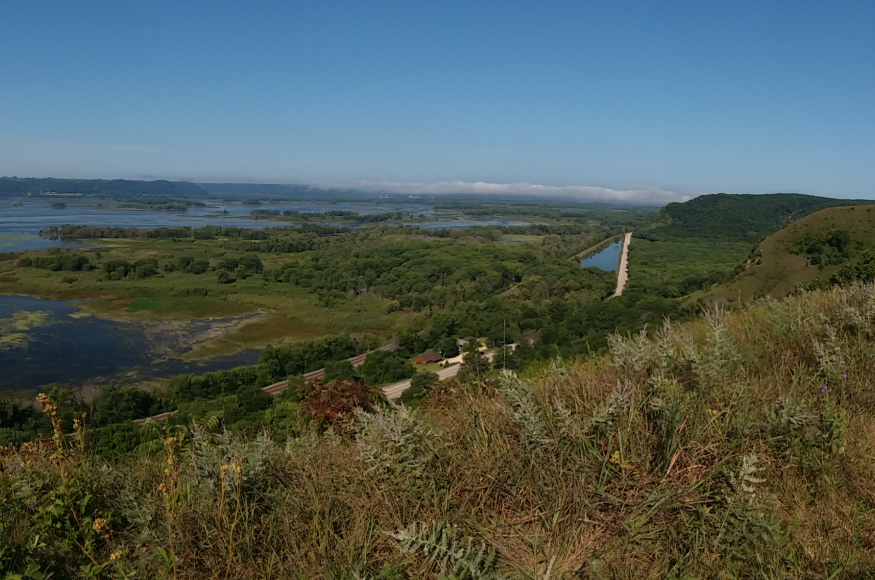Project Area
 Rush Creek State Natural Area comprises over 2,800 acres of exceptional quality dry prairie, upland oak forest/savanna, and floodplain forest along a two-mile stretch of the Mississippi River. It lies in Crawford County north of Ferryville. This site provides vital habitat for almost 50 rare and declining native species, including terrestrial and aquatic invertebrates, reptiles, birds, small mammals, fish, and plants. It also lies within the Mississippi Flyway, providing important stopover habitat for this major migratory corridor.
Rush Creek State Natural Area comprises over 2,800 acres of exceptional quality dry prairie, upland oak forest/savanna, and floodplain forest along a two-mile stretch of the Mississippi River. It lies in Crawford County north of Ferryville. This site provides vital habitat for almost 50 rare and declining native species, including terrestrial and aquatic invertebrates, reptiles, birds, small mammals, fish, and plants. It also lies within the Mississippi Flyway, providing important stopover habitat for this major migratory corridor. Characteristic plants include lead-plant, little blue-stem, side-oats grama, silky aster, blazing-star, wood betony, compass plant, and bird’s-foot violet. The narrow north and east-facing slopes bluff tops are forested with red and white oak and a significant amount of black walnut, hickory, basswood, sugar maple, and aspen. Common shrubs and mid-canopy species include gray and round-leaved dogwood, American hazelnut, sumac, and ironwood with a good diversity of woodland herbs and forbs. The spring-fed Rush Creek is cool and clear and supports a floodplain forest of silver and red maples, elm, cottonwood, river birch, and willow. The extensive nature and diversity of vegetation make Rush Creek important habitat for numerous rare plants and animals. Rush Creek is owned by the DNR and was designated a State Natural Area in 1981.
Management Goals
Goals for this property are to maintain and enhance the native communities present on site, and to enhance the quality of rare, remnant prairies. Routine site visits coordinated to facilitate completing objectives occur annually and are planned to continue for approximately or more 10 years.
Goals and objectives for forested areas:
Maintain and enhance biodiversity of understory and ground level flora in Southern Mesic/Dry-mesic Forest.
- Objectives: Reduce non-native species that compete with native flora.
Restore and enhance native community type to oak and hickory dominated woodland and savanna.
- Objectives: Reduce invasive woody species and fire-intolerant/mesic tree species by conducting prescribed burns; manage forests to increase sufficient sunlight necessary for oak regeneration.
Goals and objectives for the prairie remnant:
Enhance the quality of rare, remnant prairies on site; and improve basking habitat for both common and threatened/endangered herpetofauna
- Objectives: Cut-stump treatments and herbicide patches of invasive woody and herbaceous vegetation within and along prairie perimeter to reduce encroachment and expansion. Conduct prescribed burns to reduce presence of woody vegetation around and in remnant. To improve habitat for herpetofauna cut and remove brush around rocky outcrops to allow for more direct sunlight.
Climate Change Impacts
• Flora species likely to shift through time. Many native, mesic tree species projected to increase while some are projected to decline or remain stable. Many species however do not tolerate drought and trends show that this may be more frequently occurring in the future.
• Most oak species native to the site are projected to have the capability to cope with a changing climate.
• Prairies expected to cope well with a droughty and warmer climate.
Challenges and Opportunities
• There are uncertainties surrounding the future fate of prescribed fire application on the fire-dependent uplands of this site. It’s possible that the frequency, intensity and timing of precipitation and drought will determine if, where and when managers can burn. The threat of woody species invasion due to lack of fire may be exacerbated by carbon dioxide enrichment and nitrogen deposition.
• Species from areas to the south (both native and non-native invasives) may migrate to this site by way of the river corridor. New species may be beneficial or aggressive and carry uncertain implications for long-term ecosystem stability.
• Steep-sided ravines in the Driftless Area are especially prone to extensive erosion and even slumping of slopes with more frequent and intense storm events. Tree roots may become exposed as a result, sometimes falling into ravines and dying. Quickly changing site conditions may challenge tree regeneration efforts. Increased runoff can wash seeds of invasive species like garlic mustard into sites from adjacent lands further challenging on-going invasive species reduction efforts.
• A warmer climate aligns with native ecosystems that may be better aligned to warmer and drier conditions.
• Oak regeneration and expansion may further benefit migrating birds. However, phenological mismatches may occur affecting this wildlife species. In some years, migrating birds may find that the oaks they depend on for food have flowered earlier than usual due to unseasonal warming, resulting in fewer food insects that are associated with oak flowers. Phenological mismatch is also a serious concern for the wildflowers and native pollinators.
Adaptation Actions
Project participants used the Adaptation Workbook to develop several adaptation actions for this project, including:
4.1. Prioritize and maintain unique sites.
2.3. Manage herbivory to promote regeneration of desired species.
2.2. Prevent the introduction and establishment of invasive plant species and remove existing invasive species.
2.3. Manage herbivory to promote regeneration of desired species.
5.1. Promote diverse age classes.
5.2. Maintain and restore diversity of native species.
9.1. Favor or restore native species that are expected to be adapted to future conditions.
7.1. Reduce landscape fragmentation.
7.2. Maintain and create habitat corridors through reforestation or restoration.
8.2. Favor existing genotypes that are better adapted to future conditions.




